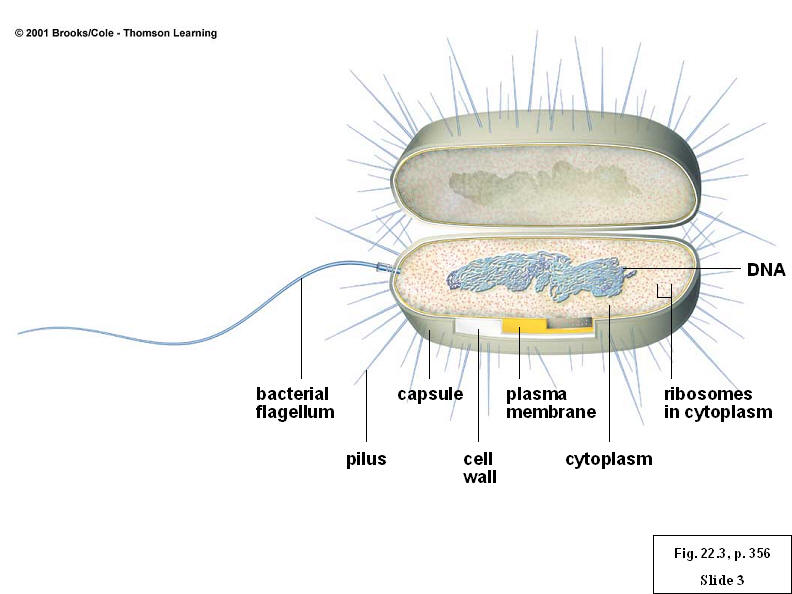
B. Anatomy
1. Cell Wall – often made of peptidoglycan
2. DNA – usually in single, circular strand
3. Plasmids – extra DNA, codes for nonvital traits
4. Ribosomes – assemble amino acids
5. Flagellum – movement
6. Plasma Membrane – under cell wall
7. Pilus – use for attachement
C. Bacterial Shapes
Coccus-
Bacillus-
Sprillum -
D. Bacterial Classification
1. Gram Positive/Negative
Gram Positive display peptidoglycan in cell wall.
2. Metabolism:
a. Photoautotroph: Use light as energy source.
b. Chemoautotroph: Autotrophs that use inorganic compounds as energy source.
c. Heterotroph
II. Bacterial Growth and Reproduction
- Asexual: Prokaryotic Fission
Circular DNA (lacking histones) replicates, then is divided between two new cells.
- Sexual Recombination: Bacterial Conjugation
A plasmid (extrachromosomal DNA) can be transferred from one bacterium to another through the extension of a sex pilus.
C. Transduction: DNA transferred through virus
When a virus infects a bacterium, it may transfer bacterial DNA when it infects other bacteria.
III. Bacterial Diversity
Section 5: Archea
Archeabacteria exist in three main groups: methanogens (live in swamps, guts of animals and other anaerobic locations), which use carbon dioxide as an electron acceptor, not oxygen, and end up producing methane. Extreme halophiles live in salty conditions such as the great salt lakes. Extreme thermophiles live in geysers and other superheated environments. These became important when Thermus aquaticus yielded an enzyme that can withstand great temperatures. This enzyme is used in the polymerase chain reaction, which is used to replicate samples of DNA.
Section 6: Eubacteria
The common bacteria in our daily life are the eubacteria. While some are dangerous, many are essential for life on earth. In the roots of some plants (legumes), bacteria live and help ‘fix’ nitrogen. Nitrogen gas is not useful for the biochemistry of life, but some photoautotrophic bacteria are able to fix the gas into nitrogen-containing products. Other eubacteria (chemoautotrophic) are able to transform ammonia into useful fertilizers. These bacteria are very active in all my aquariums. On a global scale, they are very important in cycling nutrients.
The endospore is a means of protecting the vital DNA and some cytoplasm to withstand tough periods for bacteria. The anthrax letters sent to Senator Daschle’s office contained the endospores of the bacteria Bacillus anthracis.
IV. Viruses
- Noncellular Infectious Agent
V. Viral Infection
A. There are four stages to a viral infection:
1. Attachment – the virus must be of the correct shape to ‘fool’ a host cell into importing the genetic material
(remember, large and charged items can’t pass through a cell membrane, so the virus can’t just pass through with no resistance).
2. Penetration – the entire virus, or just the genetic material, is injected into the host cell.
3. Assembly – the viral DNA is read and transcribed by the host cell. In some cases, restriction enzymes cut the host DNA and the viral genes
are inserted directly into the host genome (this is how the first restriction enzymes were discovered).
4. Release – once the viral genetic material has been translated, the new viruses are released from the cell and are set to infect other cells.
B. Lytic Virus: Cause host cell to lyse, or burst.
C. Lysogenic Virus: Displays latent period, during which virus DNA is inserted into host DNA and ‘quietly’ replicates.
D. Retrovirus: Insert RNA, then use ‘reverse transcriptase’ to copy back into DNA.